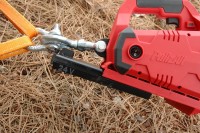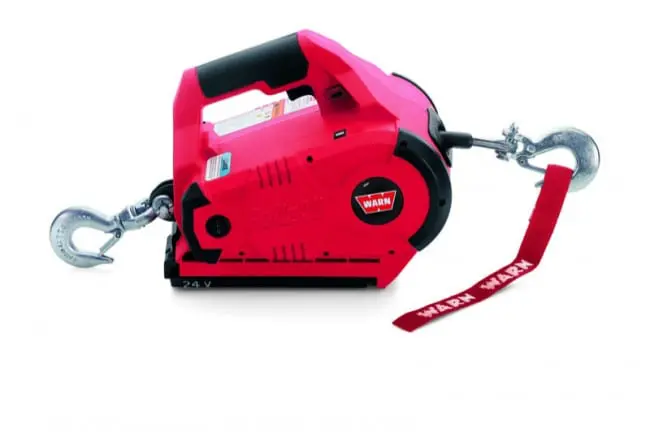The Warn cordless PullzAll is a portable motorized winch/hoist with a maximum capacity of 1,000 pounds that’s available in both corded and 24-volt cordless models. Unlike some portable winches, the DC version doesn’t rely on being wired to a nearby vehicle’s battery; it is a self-contained unit with an onboard rechargeable battery pack like other cordless tools.
Its trigger control provides nearly effortless operation when winching or hoisting (pulling or lifting a load respectively) in comparison to a come-along, cable grip puller or chain/lever hoists—all of which rely on the operator’s strength to generate their maximum power—regardless of the ultimate force rating found on a device’s nameplate. The motorized PullzAll is an equal opportunity powerhouse that allows a user of any strength to get the most out of the tool with just a pull of the trigger.
Warn Cordless PullzAll Features
Like other devices designed for hoisting work, the PullzAll has a locking brake that holds fast when it’s not advancing or reversing a load. So with its variable speed trigger it can be used to carefully position and hold loads anywhere along its 15-foot cable length as well as to move loads from point A to point B at full speed.
While the always-ready corded version seems great for use in the shop and around the yard, I have found that most of my uses for a winch or hoist find me further afield, so I have only used the cordless model. According to Warn, both models share the same performance and duty cycle specs.
Using the Warn Cordless PullzAll
I have been using a Warn Cordless PullzAll for awhile in urban and mountain logging endeavors, and I think the only thing better than having one for the various feats of strength required would be to have two. (I’m only half kidding.) During really heavy work, the going can get pretty slow, but the tool has proven to be a safe and reliable helper that has kept me and my human helpers out of harm’s way in many situations. Besides saving our backs, the PullzAll lets users stay at arm’s length from crushing loads that can quickly and unexpectedly turn on you.
Whether lifting a select beetle-kill pine out of tangled log pile to ready it for transport off the mountainside or dragging a massive yard-cut walnut trunk into my truck, the PullzAll has allowed me to harvest tons of wood that one guy and an occasional helper could never have achieved unaided.
Of course, my uses haven’t all been in pursuit of wood to mill, I have also gotten some more utilitarian work done with this versatile machine. With the PullzAll and a series/parade of steel pipe rollers, I was able to roll a small prefabricated barn onto its foundation—an ingenious use I was particularly proud of until a roller malfunction caused the building to pitch over onto its side in one of those agonizing sequences that unfolds before unbelieving eyes in slow motion. The next job for the PullzAll was righting the structure before any nearby neighbors could take note of my building prowess. Good thing both batteries were charged that day.
Most recently I used the Warn PullzAll for yanking out some shrub stumps that were quite intent on staying put. Because of its hoist brake, the PullzAll holds its full-rated load firmly in place once you let go of the trigger. I was able to do this task in steps by alternately pulling until the winch stalled, cutting the newly exposed roots with a shovel and repeating until I prevailed.
Your strenuous jobs on and off the clock may differ, but whether standing long wall assemblies, tensioning wire fences, lifting a car engine or skidding snowmobiles onto a trailer, there are tons (pun intended) of lifting and pulling tasks the portable PullzAll winch can make easier.
The Basics
The operation of the Warn Cordless PullzAll is very simple. After toggling on the unit’s main power switch, slide the direction switch to the reversing position, and pull the trigger to spool out cable. Once the load is attached, slide the direction switch to the opposite position to apply the pulling force. As with any spooled cable, it is very important to always apply tension to the cable while spooling it either in or out to avoid tangles within the winch—a condition aptly called a bird nest. Applying tension to the cable by hand before it snugs up against the resistance of the load is important to make the cable distribute itself evenly over the spool for smooth pulling and releasing. When letting down a load, the cable often jerks suddenly as it unwinds any loose wraps, but this can be minimized by taking up the cable as snugly and evenly as possible.
In order to get monstrous strength out of such a compact winch, the PullzAll is geared very low which means that it moves pretty slowly. The cable speed without any load is a leisurely eight feet per minute. In use, the take-up speed will vary greatly depending on the load, but of course it will never be any faster. To save time and battery life, I often leave whatever cable I have unspooled out of the unit between uses since I’ll just have to spool out cable to start the next job anyway. To make it easier to manage the loose cable, it really helps to keep the unit in a dedicated bag or tool box.
Warn Cordless PullzAll Accessories
Along with the PullzAll, I got Warn’s basic accessory kit that includes a duffel bag, two short (48-inch) webbing slings and two 1/2-inch shackles. It seems a bit pricey for what you get, but it is all good basic rigging gear to have for connecting the winch to a load and to an anchor point.
Another accessory item—one that I absolutely could not do without—is a snatch block (a strong pulley for cable). Besides allowing you to change the direction of your pull or lift an object while you and the PullzAll remain safely on the ground, the most important feat of a snatch block is that it effectively doubles the maximum capacity of this tool up to one ton of force. There are a lot of times that I have used the PullzAll where it couldn’t budge the load until I rigged it with a snatch block, so I think having one in your rigging kit is a necessity.
Technical Considerations
Despite its point-and-shoot simplicity, there are two technical aspects to keep in mind to get the most out of the PullzAll. The first is the issue of decreasing capacity that makes the winch effectively lose strength as it takes up more cable. As more cable is wrapped around the spool, the diameter increases and has the effect of raising the gear ratio. For the strongest pulls, Warn recommends starting with the cable pulled all the way out to its 15-foot limit. According to the brand, the maximum strength of the PullzAll (achieved just at the point the motor will stall out) is 1,000 pounds at 15 feet and drops to 750 pounds at five feet.
The other consideration is the unit’s very conservative duty cycle. The instructions specify that after one minute of operation at maximum load (or two minutes at half the maximum load) the PullzAll should be rested for 30 minutes to allow it to cool. Since the first generation unit I have been using until recently didn’t specify these drastic rest times, I’ve never observed them, and I’m not too worried about following this counterproductive schedule with the newer unit either. Self-employed or not, I can’t afford to take a half hour break after every minute or two of hard work.
In real world uses, there are a lot of pauses in the trigger time when moving heavy loads, and I have probably never run the PullzAll continuously for over a minute at a time—especially at or near maximum load condition. Besides, the motor stalls out to protect itself when it maxes out which provides pause before the tool suffers damage.
Overload Protection
When the PullzAll approaches the point of overload—at 90% of its maximum output—its green “On” light changes to a cautionary red light. Soon after, the red light blinks, and the unit’s electronic load limiter shuts down the motor to prevent damage. The LED changing to red is supposed to provide enough warning to let you back off the trigger before the unit reaches a state of overload. But in practice, as the winch snugs down between 90% and 100% of its maximum output on a load that provides too much resistance, there is only an instant separating the two conditions. Besides, watching the LED too intently would rob focus from your load and surroundings which is where your attention really needs to be directed.
My advice is to pay attention to your work, crank the tool until it stalls, and then allow it a short rest before laying on the trigger again. You will hear a click when the protective relay circuit closes. You may have to adjust something to continue moving the load, but in my experience, a series of brief full-throttle tugs while at the threshold of the tool’s capacity are often enough to finish the job. I have used the PullzAll like this several times and have yet to suffer any ill effects. I think that its protective circuit is set pretty conservatively because the designers expect users to keep pushing a heavy-duty tool like this, even when it’s struggling.
Like any power tool, just don’t overheat the motor through overuse or abuse, and you should be fine. Also, as with other electrical power tools, avoid using the trigger at its lowest setting for very long. Prolonged use near its stall speed will smoke a motor very quickly. It is better to finesse a load to its desired position with brief, full pulls of the trigger.
Dislikes

The only real problem with the PullzAll is that the battery cannot be removed when the tool is under load—the anchor hook on the back of the unit is in the way no matter how you rotate it. This means that if the battery runs down in mid-pull, the simple act of swapping it out can become a time-consuming chore. If you are dragging something on level ground, it’s no big deal to put some slack in the cable, but whenever you are pulling something up an incline or lifting a load, backing off the tension becomes a real pain. At this point you may be able to lower the load, but if the battery is spent it may not have enough power left to run the motor far enough in reverse.
The other option is to secure the load to the anchor point by another means (if you can safely reach the load’s attachment point) with a chain, come-along or heavy-duty ratcheting load strap. But if the winch cable is run through a snatch block, you probably won’t be able to do this. When I ran out of juice in the middle of my aforementioned impromptu barn raising, it proved to be quite a stressful experience to rig straps and chains to a structure lifted halfway and precariously balancing at a 45-degree angle. So I suggest putting in a fresh battery at the beginning of any critical lift to avoid this work-stopping hassle.
The PullzAll’s only other flaw is that the battery will run down completely and can be ruined if the main power switch is left on too long. A drained battery is bad enough, but a destroyed battery is a really big deal. I suggest a push button switch with a time-out feature instead of the current toggle switch. To protect your battery, it’s best to take it out of the tool, so you don’t take the chance of the switch getting bumped during transport or storage.
Battery Notes
Because the PullzAll isn’t an everyday tool, you might want to mark a reminder on your calendar to charge its batteries every six months. Nickel Metal Hydride batteries are reputed to be temperamental and may refuse to take a charge if neglected for a few years. It’s true. I have an unused spare PullzAll battery that I let sit too long that will no longer take a charge at all.
In their updated owner’s manual, Warn notes that the maximum shelf life of a sitting battery is two years, but they recommend charging the batteries every six months. The charger takes an estimated two hours to recharge the battery, so you need to make sure your batteries are charged before you head for the back 40. It’s no fun to wait two hours before finishing a pull.
Application Limitations
Although support literature for the PullzAll has pictured the unit being used to raise large beams and the like, the fact that you have to have one hand on the unit to operate it severely limits the high lifts it can perform safely in my opinion. It’s dangerous enough to be on a ladder next to a hanging load that is free to swing, but it’s especially risky if you have to climb the ladder alongside whatever you are lifting with only one hand on the ladder.
My advice would be to hoist through a snatch block or other pulley above, so you can keep your feet on the ground. Attaching an extension cable or a suitable rope to the end of the PullzAll’s cable will allow you to use most of its 15-foot range for lifting. Alternately, you should manage the lift from above, so you can stay put on a ladder or scaffold—your last choice should be ascending a ladder next to the load with one hand on the winch.
The Product Line
The PullzAll was originally released in orange as part of the company’s Warn Works sub-brand, but it has since switched to Warn’s signature shade of red. According to the company, the motor and transmission remained the same, so despite the color change, both units perform with the same power.
This spring Warn released a version of the PullzAll decked out in camouflage. (I guess in case you want it to be easier to lose in the woods.) The red version is stylish enough for me, especially considering the greater-than 20-percent up-charge for the camouflage graphics.
To reduce the price of the cordless units, they will now be sold in kits with only one battery. The camo unit is already being sold this way, and when the existing two-battery red PullzAll kits sell out, they will be replaced with a single battery version. Given the current price of a single battery pack, this marketing change will undoubtedly cost buyers who want two batteries with their PullzAll significantly more.
Specifications
- Force: 1,000 lbs. max (2,000 lbs. w/snatch block)
- Range: 15 ft. (7-1/2 ft w/snatch block)
- Weight: 18 lbs.
- Battery: 24V NiMH (cordless model)
- Price (cordless): $354 (w/two batteries)
- Price (corded): $181
- Available accessories: Battery pack, Rigging kit, 9,000 lbs. snatch block
























